Table of content
Cooking delicious fresh pig’s intestines might seem like an intimidating task for many, but with the right techniques and ingredients, it can transform into a mouthwatering dish that’s both savory and satisfying. Pig’s intestines, also known as chitterlings or variety meats, are a popular ingredient in various cuisines around the world, particularly in Asian, Latin American, and Southern American cooking. This guide aims to demystify the process of preparing and cooking fresh pig’s intestines, ensuring that you can enjoy a delicious meal that’s both flavorful and tender.
Understanding Fresh Pig’s Intestines
Before diving into the cooking process, it’s essential to understand what fresh pig’s intestines are and how to select high-quality ones. Pig’s intestines are the tubular organs that are part of the digestive system of a pig. They come in two main varieties: small intestines and large intestines. For culinary purposes, the small intestines are more commonly used due to their thinner walls and milder flavor.
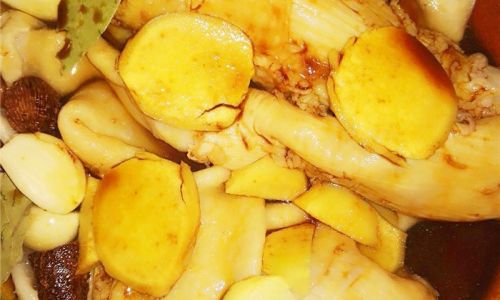
When purchasing fresh pig’s intestines, look for ones that are firm, have a slightly glossy appearance, and have no visible signs of discoloration or odor. They should be cleaned thoroughly by the butcher or you can clean them yourself at home. Proper cleaning is crucial to remove any impurities and ensure a pleasant eating experience.
Cleaning Fresh Pig’s Intestines
Cleaning fresh pig’s intestines is a vital step in the preparation process. It requires patience and attention to detail but is relatively straightforward. Here’s a step-by-step guide to cleaning your intestines:
-
Rinse Under Cold Water: Start by rinsing the intestines under cold running water. This helps to remove any loose debris or external impurities.
-
Trim the Ends: Cut off any excess fat, membranes, or tough ends from the intestines. This makes them easier to handle and cook.
-
Turn Inside Out: Carefully turn the intestines inside out. This can be done by inserting one end of the intestine onto a faucet and slowly turning on the water, allowing the pressure to flip the intestine inside out. Alternatively, you can use a chopstick or your fingers to manually turn them.
-
Scrub and Rinse: Once inside out, use a stiff brush or the back of a spoon to scrub the interior surface gently but thoroughly. This removes any remaining debris, fat, or residue. Rinse frequently under cold water to wash away any scrubbing debris.
-
Inspect and Repeat: Carefully inspect the intestines for any remaining impurities. Repeat the scrubbing and rinsing process as necessary until the interior surface is clean and free of debris.
-
Turn Right Side Out: Once the interior is clean, turn the intestines back to their original position. Rinse them once more under cold water to ensure they are completely clean.
-
Soak in Saltwater: Place the cleaned intestines in a large bowl of cold water with a few tablespoons of salt. Allow them to soak for about 30 minutes to an hour. This helps to draw out any remaining impurities and adds a subtle flavor.
-
Rinse and Pat Dry: After soaking, rinse the intestines thoroughly under cold water and pat them dry with paper towels. They are now ready for cooking.
Cooking Methods for Fresh Pig’s Intestines
There are several cooking methods you can use to prepare fresh pig’s intestines. Each method offers a unique texture and flavor profile. Here are some popular cooking techniques:
Boiling
Boiling is a straightforward and effective way to cook pig’s intestines. It tenderizes the meat and allows for the absorption of flavors from seasonings and spices.
Ingredients:
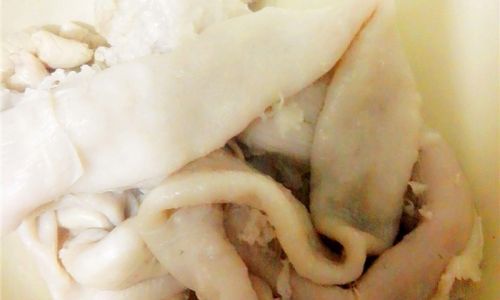
- Cleaned pig’s intestines
- Water
- Salt
- Onion (optional)
- Garlic (optional)
- Bay leaves (optional)
- Black peppercorns (optional)
Instructions:
- Fill a large pot with enough water to fully submerge the intestines. Add salt and any optional aromatics like onion, garlic, bay leaves, and black peppercorns.
- Bring the water to a boil.
- Carefully add the intestines to the boiling water. Reduce the heat to a simmer and cook for about 1 to 1.5 hours, or until the intestines are tender and cooked through.
- Remove the intestines from the pot and allow them to cool slightly. You can then slice them into bite-sized pieces and use them in various dishes.
Stir-Frying
Stir-frying pig’s intestines is a quick and delicious way to prepare them, especially if you enjoy a bit of crunch and caramelization.
Ingredients:
- Cooked and sliced pig’s intestines
- Vegetable oil
- Garlic (minced)
- Ginger (minced)
- Onion (sliced)
- Bell peppers (sliced)
- Soy sauce
- Oyster sauce (optional)
- Sugar (optional)
- Salt and pepper to taste
- Green onions (chopped, for garnish)
Instructions:
- Heat a large skillet or wok over medium-high heat. Add vegetable oil and swirl to coat the bottom.
- Add the minced garlic and ginger, and stir-fry for about 30 seconds until fragrant.
- Add the sliced onion and bell peppers, and stir-fry for another 2-3 minutes until they begin to soften.
- Add the cooked and sliced pig’s intestines to the skillet. Stir-fry for about 5 minutes, until they are heated through and slightly caramelized.
- Pour in soy sauce and, if using, oyster sauce and sugar. Stir to combine and cook for another 1-2 minutes until the sauce thickens slightly.
- Season with salt and pepper to taste. Garnish with chopped green onions before serving.
Stewing
Stewing pig’s intestines is a great way to infuse them with rich, deep flavors. This method is perfect for dishes that require a long, slow cooking process.
Ingredients:
- Cooked and sliced pig’s intestines
- Vegetable oil
- Garlic (minced)
- Ginger (minced)
- Onion (sliced)
- Tomatoes (diced)
- Tomato paste
- Beef broth or chicken broth
- Soy sauce
- Brown sugar (optional)
- Star anise (optional)
- Cinnamon stick (optional)
- Salt and pepper to taste
- Green onions (chopped, for garnish)
Instructions:
- Heat a large pot or Dutch oven over medium heat. Add vegetable oil and swirl to coat the bottom.
- Add the minced garlic and ginger, and stir-fry for about 30 seconds until fragrant.
- Add the sliced onion and diced tomatoes, and stir-fry for another 3-4 minutes until the onions are translucent and the tomatoes begin to soften.
- Stir in the tomato paste and cook for another 1-2 minutes until it darkens in color.
- Pour in the beef or chicken broth, soy sauce, and, if using, brown sugar, star anise, and cinnamon stick. Stir to combine.
- Add the cooked and sliced pig’s intestines to the pot. Bring the mixture to a simmer, then reduce the heat to low. Cover and cook for about 1 to 1.5 hours, or until the intestines are very tender and the sauce has thickened.
- Season with salt and pepper to taste. Garnish with chopped green onions before serving.
Grilling
Grilling pig’s intestines offers a smoky, charred flavor that’s perfect for outdoor cooking. This method works best with thinly sliced pieces of cooked intestines.
Ingredients:
- Cooked and thinly sliced pig’s intestines
- Olive oil
- Salt and pepper to taste
- Your favorite grilling spices (e.g., paprika, cumin, garlic powder)
- Lemon wedges (for serving)
Instructions:
- Preheat your grill to medium-high heat.
- In a bowl, toss the cooked and thinly sliced pig’s intestines with olive oil, salt, pepper, and your favorite grilling spices.
- Place the seasoned intestines on the grill grates. Grill for about 2-3 minutes per side, or until they are nicely charred and heated through.
- Serve hot with lemon wedges on the side for a refreshing, tangy contrast.
Seasoning and Flavor Profiles
When cooking pig’s intestines, seasoning is key to enhancing their flavor and making them more palatable. Here are some popular seasoning and flavor combinations to try:
- Asian-Inspired: Use soy sauce, ginger, garlic, sesame oil, and green onions for a classic Asian flavor profile.
- Latin American: Incorporate cumin, chili powder, cilantro, lime juice, and onions for a spicy, tangy taste.
- Southern American: Add barbecue sauce, brown sugar, vinegar, and mustard for a sweet and tangy barbecue flavor.
- Mediterranean: Use olive oil, lemon juice, oregano, thyme, and garlic for a fresh, aromatic flavor.
Serving Suggestions
Pig’s intestines can be served in various ways, depending on your preference and the



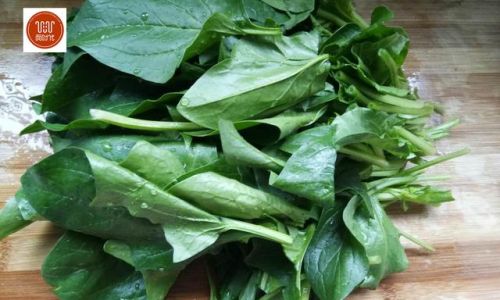
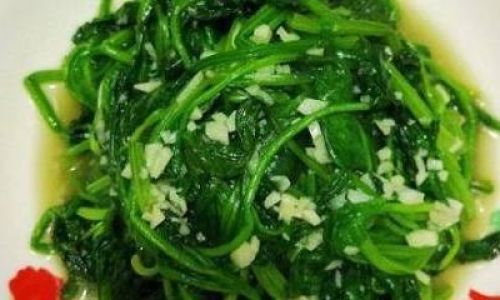
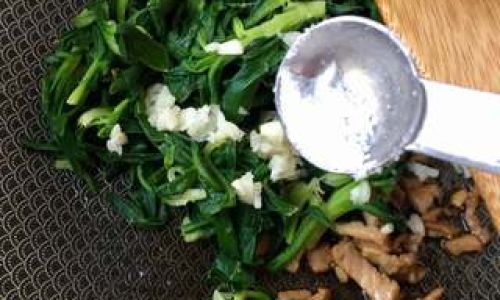
0 comments